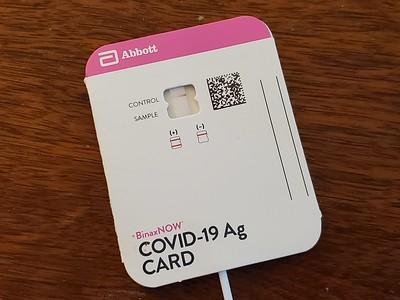A single-center study conducted at a free community testing site in Maryland suggests that patient-administered BinaxNow COVID-19 rapid antigen tests (RATs) have similar accuracy as those performed by a clinician, although the results can be misinterpreted or falsely negative.
Researchers from the Baltimore Convention Center Field Hospital and Johns Hopkins University and their collaborators compared the sensitivity and specificity of Abbott's BinaxNOW home RAT with those administered by a healthcare provider and reverse transcription-polymerase chain reaction (RT-PCR) from February to July 2022, a period of Omicron variant predominance.
The median age of the 953 participants was 34 years, 60.6% were women, 58.6% were White, 98.2% were English-speaking, and 34.1% had at least one COVID-19 symptom. Hospital staff administered both a RAT and an RT-PCR test to participants, who then self-tested with a RAT, the results of which were both self-reported and reviewed by the researchers.
"The public and clinicians continue to use the results from self-tests, assuming their accuracy is comparable to that of clinician-performed tests," the study authors noted. "However, self-tests might exhibit a higher rate of false negatives due to inadequate sampling or false positives due to inadvertent sample contamination by untrained individuals or from misinterpretation of visual results."
The findings were published yesterday in Microbiology Spectrum.
22 infections missed by both participants, staff
RT-PCR determined that 14.9% of the 953 participants had COVID-19. The sensitivity and specificity of the self- and clinician-administered RATs were similar (83.9% vs 88.2% and 99.8% vs 99.6%, respectively). For reference, the World Health Organization's minimum test sensitivity benchmark for people with symptoms is 80%. Age-, race-, and symptom-based subgroup comparisons produced comparable results.
Sensitivity is the probability that a test correctly identifies all positive cases; the higher the sensitivity, the lower the likelihood of false-negative results. Specificity, on the other hand, is the ability to identify those who don't have a condition; the higher the specificity, the lower the risk of false-positive results.
Of the 177 positive COVID-19 tests, participants and staff accurately identified 145 (81.9%) as positive on RAT. Nine infections (5.1%) were missed by participants (false-negatives) but correctly identified by staff. Twenty-two cases (12.4%) were missed by both participants and staff. In one case (0.5%), staff incorrectly interpreted the result as negative after the participant correctly interpreted it as positive.
Interpretations of RT-PCR–positive results showed 94.4% interrater agreement between participants and staff. A total of 776 participants tested negative on RT-PCR. Interpretations of RT-PCR–negative results demonstrated 99.4% interrater agreement.
Previous studies of RATs, including BinaxNow, by different research groups have had a range of results, leading to concerns about their limitations and the false reassurance they can provide. For example, a 2021 study by the US Centers for Disease Control and Prevention concluded that, compared with RT-PCR, BinaxNOW had a sensitivity of 64.2% for samples from people with symptoms and 35.8% for asymptomatic people, with a specificity of nearly 100%.
Another study, published in 2022 by Naval Medical Research Center researchers, found a sensitivity and specificity of BinaxNOW of 69.7% and 71.0%, respectively.
Convenience, more timely testing
"Given that PCR-positive patients, who were missed by self-interpretation but caught by staff re-reads, had higher CT counts [an indication of lower viral load] than those identified as positive by both, and lower than those missed by both, it is even more critical to perform self-tests immediately at symptom onset or as early as possible," the study authors wrote.
The researchers said that the results have significant implications for clinicians prescribing COVID-19 treatment based on patient-reported findings. They added that home RATs enable more timely testing after virus exposure or symptom onset, which may promote early detection and therefore aid in disease control.



















